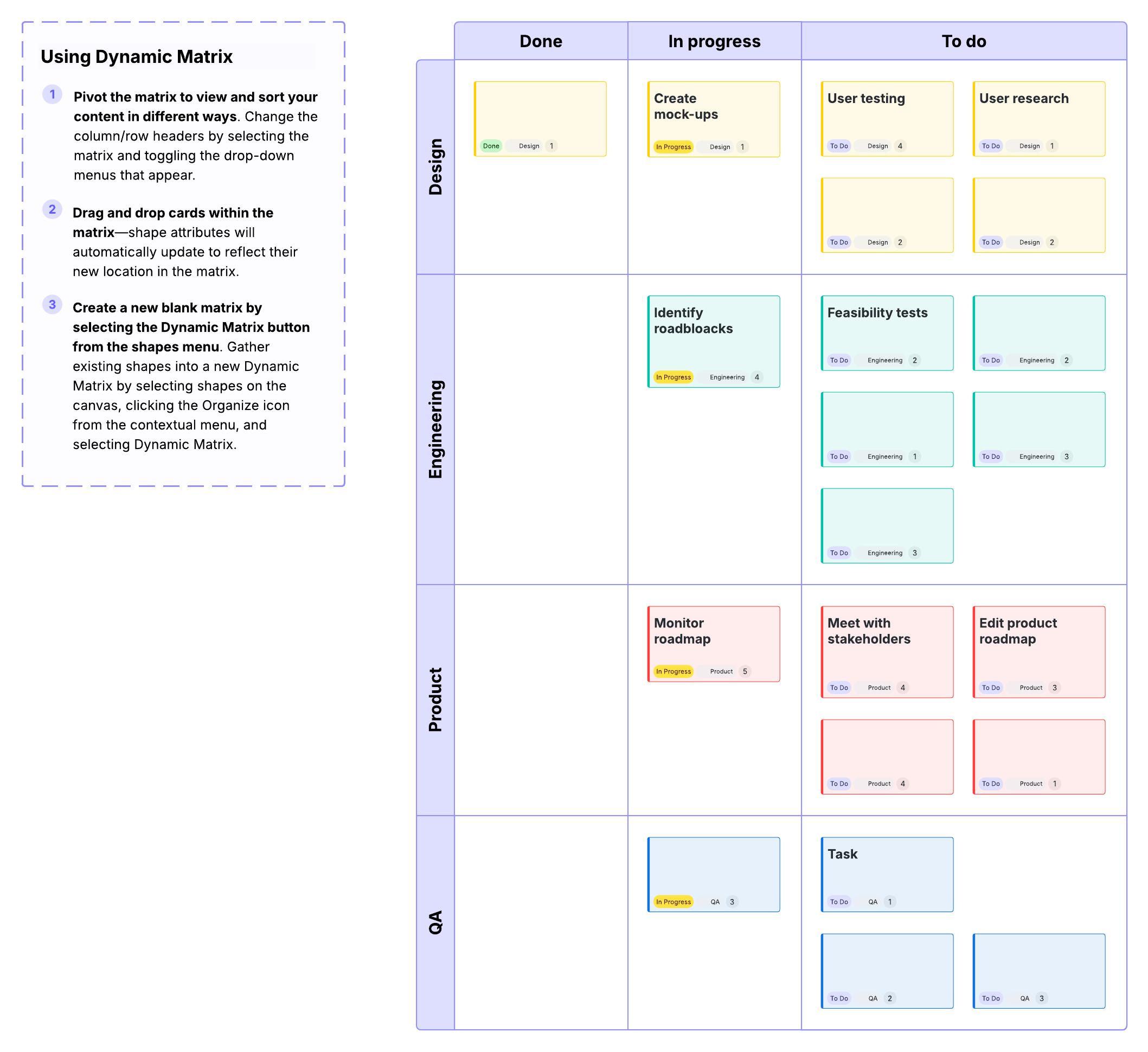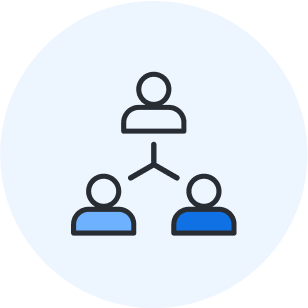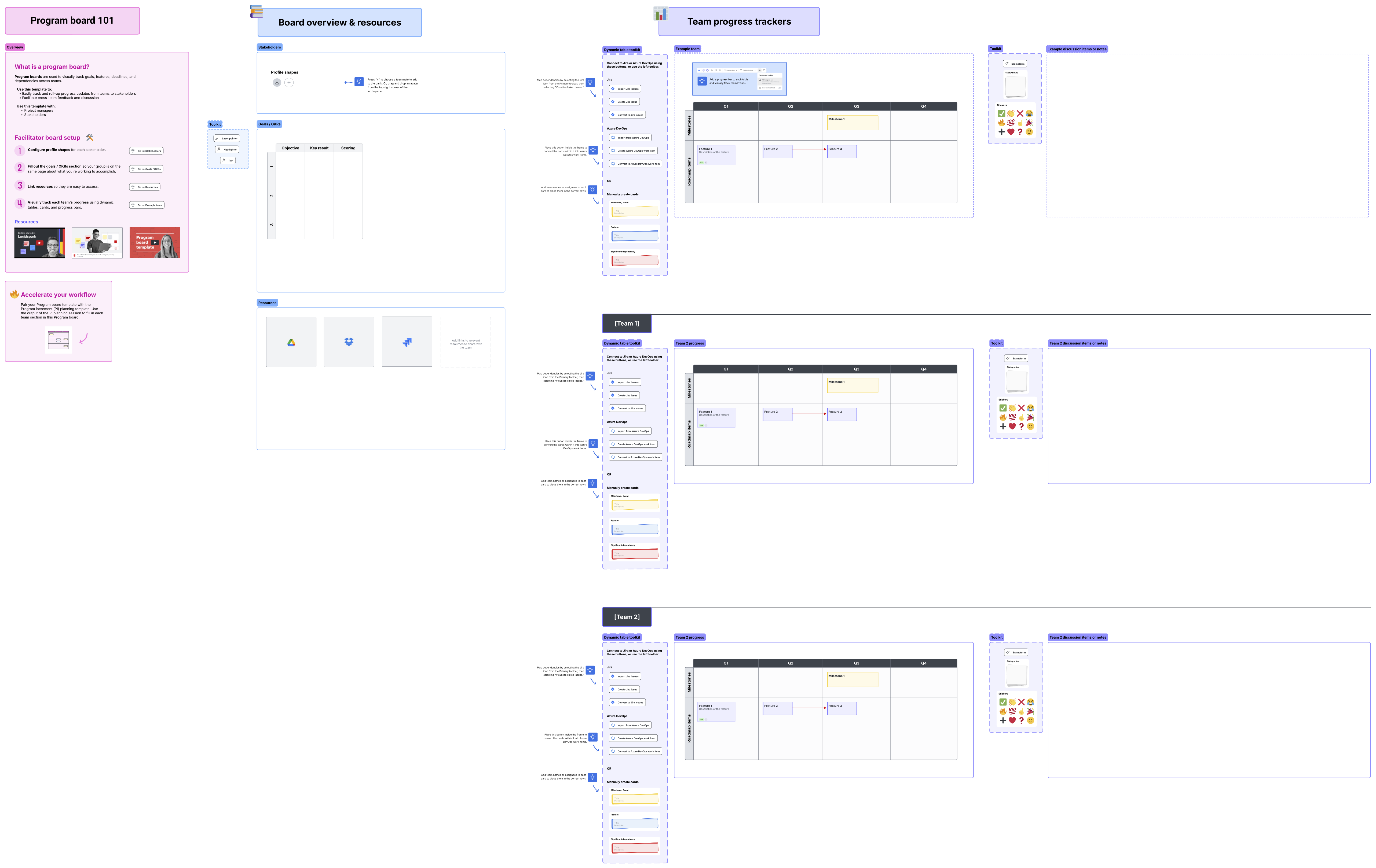There are a few frameworks that organizations can use to implement Agile at scale, and SAFe is the most considered and adopted framework for scaling Agile. According to the State of SAFe Report 2025, companies often customize their approach to SAFe, choosing to blend aspects of the SAFe framework with existing operating models and flow-based ways of working.
Regardless of how organizations choose to scale Agile, they need a solution to enhance alignment, transparency, and communication as multiple Agile teams work in tandem. With so many people involved in SAFe events such as PI planning and Agile Release Train (ART) syncs, companies need a way to centralize resources and keep track of work in progress while ensuring that teams are working effectively.
This is where Lucid steps in, providing a way to help teams scale documentation, increase visibility, and share proven ways of working as they accelerate transformation across the business. Read on to learn how Lucid supports the SAFe framework, thanks to powerful capabilities, ready-to-use templates, and features that were built for Agile teams.
Using visual collaboration for the 10 principles of SAFe
As businesses aim to scale Agile, visual collaboration is incredibly useful for implementing SAFe’s guiding principles. By using visual collaboration across your organization, it’s easier to help your organization adopt Lean-Agile thinking as you maintain collaboration across multiple teams, gain insight into work in progress, and identify potential risk.
Agile teams can use Lucid to support the 10 principles of SAFe, including:
-
Applying systems thinking. A visual solution helps you map out your organization’s systems and processes, gaining insight into how components are related so you can understand interdependencies, bottlenecks, and other potential problems. Visualizing your system makes it easier to identify areas of improvement.
-
Assuming variability and preserving options. Lucid’s capabilities help teams plan multiple options and assume there will be variables so teams can more quickly adapt. A visual solution isn’t static and is kept up to date with the latest information, so it’s easier for teams to see how variability makes an impact and factor change into their plans.
-
Making value flow without interruptions by visualizing work in progress and making this work visible to multiple teams and stakeholders. Visual documents like Kanban boards limit work in progress and keep teams focused on their goals as they maintain a manageable cadence.
-
Decentralizing decision-making. A visual collaboration solution gives each person an equal opportunity to be heard and empowers individuals closest to the work to provide input. By enhancing strategic decision-making, Lucid helps teams solve problems more quickly to increase their responsiveness and adaptability.
How Lucid supports the SAFe framework
As teams implement Agile at scale, Lucid empowers them to plan and communicate effectively, achieve alignment, and leverage standardized documentation across the organization. Here are the ways that your team can use Lucid to successfully apply the SAFe framework.
Creating a single source of truth
Since SAFe involves multiple cross-functional teams, it’s even more important to have a central repository for resources and documentation so everyone is on the same page. Agile teams can use Lucid as a single source of truth to enhance transparency and alignment, keeping all of their resources in one place.
With team hubs, Lucid makes it easy to centralize documentation. Each team hub in Lucid has a dedicated team space, team roster, and a collection of all relevant documents. People can regard their team hub as a home base for coordination where they discuss work, make decisions together, and stay organized.
With Lucid’s Agility Accelerator, designated Agile managers can create team hubs at scale so that everyone in your Agile Release Train (ART) has access to the same resources. Thanks to the Agility Accelerator, it’s easy to create team tags and group teams by initiative. Agile managers can also create blueprints, which are sets of templates that provide a starting point for work.

With these features, a release train engineer (RTE) can ensure that everyone across teams remains in sync and quickly gets started with proven ways of working. By using Lucid, Agile teams easily find the documentation they need, including technical diagrams that are essential to SAFe, such as product roadmaps and architecture diagrams, and continue their work without missing a beat.
Managing an ART backlog
It’s no small task for product managers to map out the features that will ultimately be delivered by the ATR and oversee work to be done by multiple teams. PMs can create and manage ART backlogs in Lucid, visualizing and prioritizing features for the whole train while ensuring that each team executes the right work to deliver those features.
Product managers often use a Kanban system, showing work that’s completed, in progress, and to be done. Customizable Kanban templates in Lucid help PMs visualize PI objectives and enhance transparency on work in progress for each team. With intelligent features such as Dynamic Tables and conditional formatting, PMs can organize features by team and streamline their Agile planning.

In ART backlogs, team capacity needs to be considered and effectively allocated to make sure that teams aren’t overloaded while the ART continues to make progress on its mission. Luckily, with the Agility Accelerator, teams can conduct capacity planning to visualize how much work they can realistically take on.
On top of this, PMs can conduct scenario planning to explore multiple “what-if” scenarios. Test out different scenarios in the Agility Accelerator without disrupting any data in your existing system of record, then turn syncing back on when you’re ready to move forward with a decision.
Lucid’s enhanced planning features enable PMs to account for varying factors while ensuring that teams work at a sustainable pace.
Facilitating PI planning
With PI planning occurring a few times a year as all teams on the ART come together, organizations need to be able to map out how each team will deliver features that support the overall product vision. Lucid is the solution for bringing dozens of team members from across the organization together in one place, keeping everyone aligned during PI planning while also giving everyone an equal opportunity to participate.
Visual collaboration enhances alignment and participation during PI planning sessions. Use a PI planning template in Lucid to facilitate interactive, collaborative meetings that help multiple teams align on goals and objectives. Virtual planning sessions are especially beneficial for hybrid or distributed teams, giving remote workers an equal chance to provide input. And, with breakout boards, you can conduct breakout sessions that support smaller group work, making it easier to focus on each team in the ART.

During PI planning, companies should also visualize dependencies that may occur between teams as they aim to complete PI goals. In Lucid, teams can conduct dependency mapping to identify and then eliminate or mitigate dependencies, effectively planning the next program increment with transparency into potential risks. Thanks to Lucid’s integrations with Jira and Azure DevOps, any change in your existing system of record will be automatically reflected in Lucid due to bi-directional syncing.
By conducting PI planning in Lucid, you can successfully set PI objectives for each team and create a high-level plan that establishes cross-team alignment.

How one company used Lucid to enhance virtual PI planning
Read about an insurance company that used Lucid for their PI planning events and saw a 200% increase in participation.
Read moreStandardizing with SAFe templates
Beyond PI planning, Lucid has an entire library of customizable, ready-to-use Agile templates that take Agile teams all the way from initial planning to hosting retrospectives. These templates help Agile teams quickly get started and standardize how SAFe events are facilitated. And, with the Agility Accelerator, Agile managers can use blueprints to drive standardization by sharing the same templates across teams.
Lucid’s Agile templates include ART planning boards (formerly known as program boards), brainstorming activities, SAFe ROAM boards, comprehensive retrospectives, and more. Many Agile teams use Lucid for brainstorming sessions and strategic decision-making. Enhanced features such as private mode and Visual Activities make it easier to encourage engagement and foster psychological safety among team members.
Use Lucid’s templates to kick-start iteration planning, refine your systems and processes, and identify ways that you can keep improving.

Gathering qualitative data
As companies use SAFe to implement Agile across the organization and multiple teams work together to achieve incremental product delivery, it’s essential to understand qualitative factors that impact team members. These factors can range from how confident people feel in their team’s ability to deliver on goals to whether they feel overburdened. Without a way to record and access this qualitative data, an organization can experience team burnout or other risks as it scales Agile.
With Lucid’s Agility Accelerator, Agile managers can gather and track qualitative data by locking Visual Activities or specific frames within blueprints. The data is aggregated into a comprehensive insights dashboard that shows team health at a glance, highlighting team confidence, concern, risks, and more. It’s easy to share insights from the dashboard with leadership or other teams. Thanks to this capability, team members can be honest about their overall sentiment while remaining focused on their work.

Planning and documenting with intelligent diagramming capabilities
In a SAFe context, Lucid is extremely helpful for planning and documenting visuals. Teams and RTEs can use Lucid to create diagrams that map out complex processes or systems in an easy-to-understand way and then share these diagrams across teams or with stakeholders.
For example, during PI planning, a product manager or system architect could include a diagram in their template to show an end-to-end solution such as a value stream map. Value stream mapping is essential for PI planning since it shows the exact sequence of activities necessary to deliver value. Teams that practice SAFe can form ARTs for each value stream that exists in their organization and use Lucid to visualize and manage those value streams.

Not only does Lucid help with value stream mapping, but Agile teams can also create org charts for new ARTs, and RTEs can diagram team structures. With data linking, your diagrams in Lucid contain the most up-to-date information, further enhancing transparency and ensuring that your plans stay updated as situations evolve.
Using Lucid to boost agility and innovation
Adopting SAFe is one of many ways that companies embark on the Agile journey, and Lucid supports every stage of that journey. Organizations around the world use Lucid to enhance transparency and alignment regardless of whether they’re using SAFe or other Agile frameworks. With visual collaboration, teams can scale proven ways of working, centralize documentation, and facilitate effective planning sessions that kick-start incremental delivery of value.
Learn more about how Agile teams use Lucid as an end-to-end solution to streamline connection and improve how they accomplish their work.

How Agile teams use Lucid
Learn how Lucid’s Agile resources and capabilities help teams with alignment and connection.
Read moreAbout Lucid
Lucid Software is the leader in visual collaboration and work acceleration, helping teams see and build the future by turning ideas into reality. Its products include the Lucid Visual Collaboration Suite (Lucidchart and Lucidspark) and airfocus. The Lucid Visual Collaboration Suite, combined with powerful accelerators for business agility, cloud, and process transformation, empowers organizations to streamline work, foster alignment, and drive business transformation at scale. airfocus, an AI-powered product management and roadmapping platform, extends these capabilities by helping teams prioritize work, define product strategy, and align execution with business goals. The most used work acceleration platform by the Fortune 500, Lucid's solutions are trusted by more than 100 million users across enterprises worldwide, including Google, GE, and NBC Universal. Lucid partners with leaders such as Google, Atlassian, and Microsoft, and has received numerous awards for its products, growth, and workplace culture.
Related articles
How Agile teams use Lucid to enhance alignment, transparency, and connection
Check out how Agile teams use Lucid to boost alignment, connection, and more.
How 7 companies use Lucid to improve Agile processes and increase efficiency
Check out how Lucid helped these seven companies enhance their agility and efficiency.
What is PI planning? An in-depth guide + templates
Learn all about PI planning, how to host SAFe PI planning meetings, and who should be involved.
How the Scaled Agile Framework (SAFe) can help you to scale your business practices
SAFe improves collaboration, increases flexibility, and better aligns project strategies and goals. Learn how to best implement SAFe on your team.

